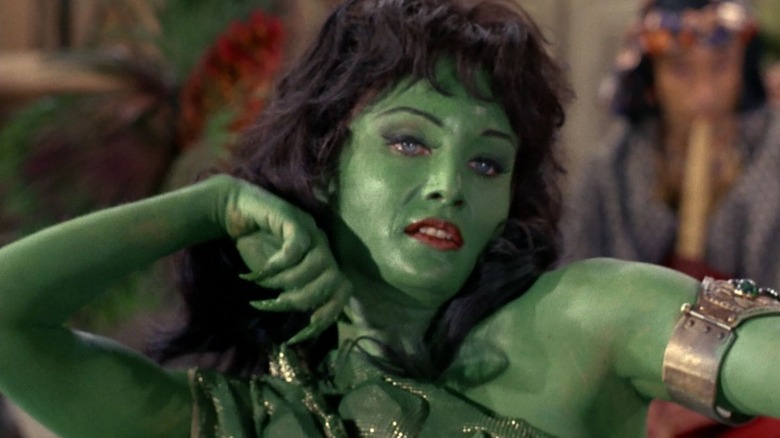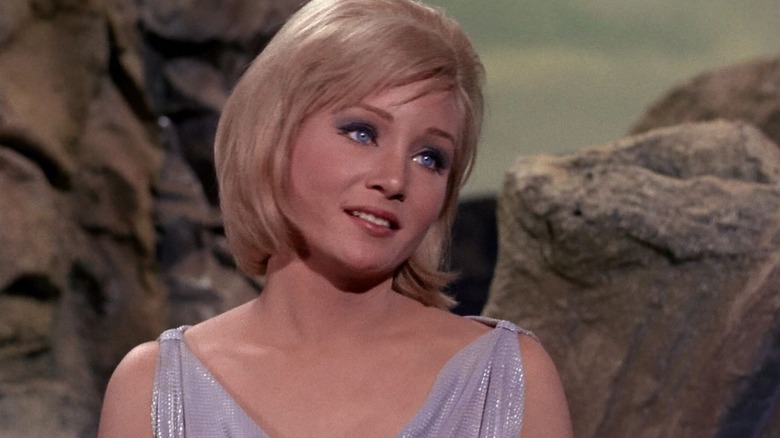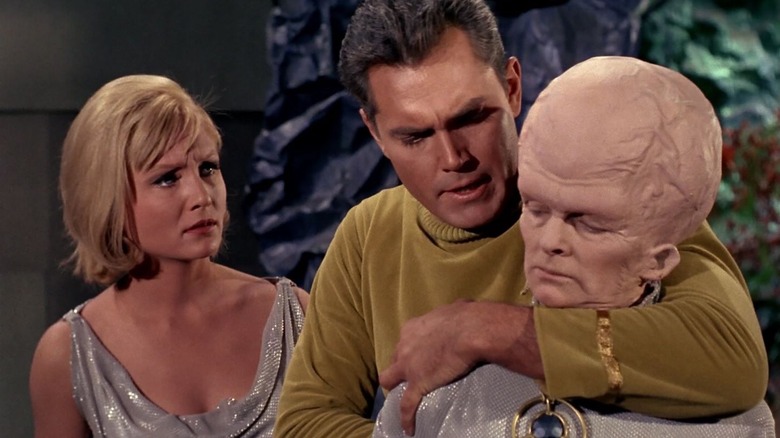This Star Trek Actor Became A Pioneer In Aviation After A Near-Death Jet Experience
We may receive a commission on purchases made from links.
The original pilot episode for "Star Trek," called "The Cage," was screened for NBC executives in 1965, but it was initially turned down. The execs told creator Gene Roddenberry he was on to something, though, and he re-worked the series at the last minute, replacing every single character but one (Spock, played by Leonard Nimoy). The original pilot would eventually be repurposed as a two part episode of "Star Trek" called "The Menagerie," which aired on November 17 and 24, 1966. The uncut version of "The Cage" wouldn't reach the public until the mid-1980s.
"The Cage" featured Captain Christopher Pike (Jeffrey Hunter) and his run-in with a species of creepy, large-headed psychic aliens called Talosians. The Talosians were fascinated by humans, and imprisoned Pike in a subterranean cell, where they fed him a series of psychically-induced play-acting scenarios. There was only one other humanoid prisoner among the Talosians: Vina, a pretty blonde human woman whom Pike develops a great deal of sympathy for. Vina is forced to play-act in Pike's fantasies, appearing in one as a medieval damsel in distress. More famously, Vina was transformed into a green-skinned Orion slave who was forced to provocatively dance for Pike and several other lascivious men.
Vina was played by actress Susan Oliver, a woman with a long and very interesting career. Oliver began appearing on TV in 1955, showing up in TV movies and televised plays on anthology shows like "Goodyear Playhouse" and "The Kaiser Aluminum Hour." She had many, many guest spots on multiple hot TV shows of the day, including "Father's Knows Best," "Wagon Train," and "Bonanza." She had dozens of credits by the time she appeared on "Star Trek."
In 1959, Oliver's career was temporarily stymied when she survived a horrendous plane incident. To recover from the event, Oliver ended up taking flying lessons in Santa Monica, California, and spent many years as a professional pilot with an impressive flying record.
Susan Oliver became a pilot after surviving a plane crash
As recounted in an Aviation History article (via Historynet), Susan Oliver was a passenger on the ill-fated Pan Am Flight 115, one of the more notorious airplane mishaps up to that point. The incident took place on February 3, 1959 — which was, coincidentally, the same day that Buddy Holly, the Big Bopper, and Richie Valens all died in a famous plane crash of their own. The story goes that the plane's pilot left the cockpit while the autopilot was engaged, but that the autopilot didn't keep the plane level. The Boeing 707-121 went from its cruising altitude of 35,000 feet to a terrifyingly low 6,000 feet. The plane, which was flying from Paris to New York City, had to make an emergency landing in Newfoundland.
Susan Oliver was so terrified by the event that she refused to fly thereafter. She described it by saying that "somewhere over the middle of the Atlantic, we suddenly went bump in the night, as if the plane had hit an air pocket, and with a sharp lunge started falling, tumbling hard." Eventually she was taken to LaGuardia Airport, but as she landed, she witnessed emergency clean-up of yet another plane crash that had just occurred in the East River. Her own plane experience, her witnessing of the wreckage, and news of the Day the Music Died was enough to put Oliver off planes for a long time.
As Oliver explained in her autobiography, "Odyssey: A Daring Transatlantic Journey," she had to undergo hypnosis therapy to overcome her fears. In 1964, a local L.A. newscaster named Hal Fishman took her on a short flight in his light Cessna, taking off from the Santa Monica airport. Oliver loved the experience, and went back the following day for lessons of her own. After that, she became obsessed with planes, and even started to think that she could pilot overseas flights on her own.
Susan Oliver survived a small plane crash while training for a Transatlantic flight
Oliver was already flying solo by the time she auditioned for "Star Trek," and was even gearing up for a Transatlantic flight. She would fly herself to auditions and film sets. Oliver also had to fight through the trauma of yet another plane crash shortly after her "Star Trek" gig. It seems that she was the passenger in a small light plane when some hot-dogging a-hole pilot tangled it up in some telephone wires and flipped it over. Both Oliver and the pilot were uninjured, and the actress wasn't deterred. She kept on flying, determined to make a solo Transatlantic flight.
In 1967, Oliver got in an Aero Commander 200, specially outfitted with an extra fuel tank, and made the trip. She packed an oxygen tank, an emergency life raft, and even learned some Russian (as she planned on landing in Moscow). She took off from New York City, and, after a few stops along the way, finally landed in Copenhagen, Denmark. Oliver was only the fourth woman to make a Transatlantic flight. She wasn't able to go all the way to Moscow because the Soviet Union denied her entry into the country. She never found out exactly why, however, writing: "No one in that sad, gray other country will even say why I'm not allowed to fly my pretty Bluebird into their private yard."
After that, Oliver acted incessantly, remaining on television in dozens and dozens of guest spots. In 1970, she also took to the director's chair, helming episodes of "M*A*S*H" and "Trapper John, M.D." Her final acting gig was in a 1988 episode of "Freddy's Nightmares." All the while, Oliver continued to practice flying, becoming rated in gliders, and zipping around the country for acting jobs. She passed away in 1990 at the age of 58, from colon cancer.
Susan Oliver lived an epic life, and her exploits should all be celebrated.


